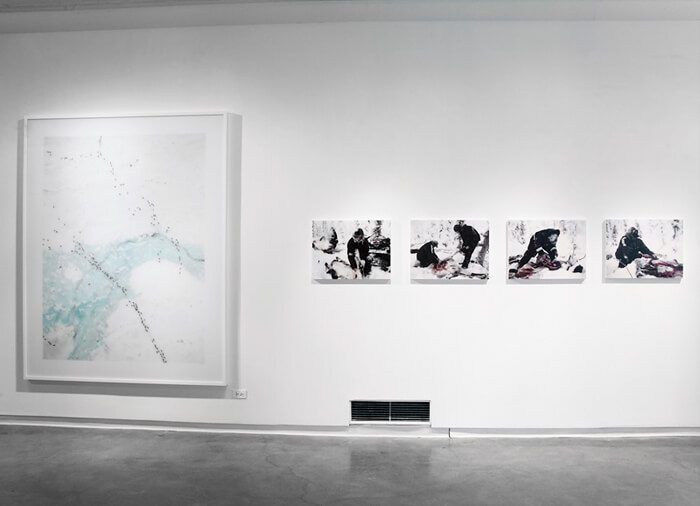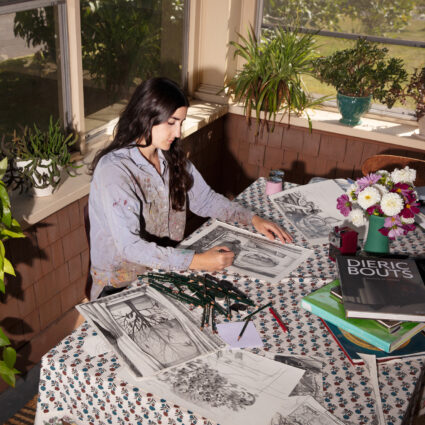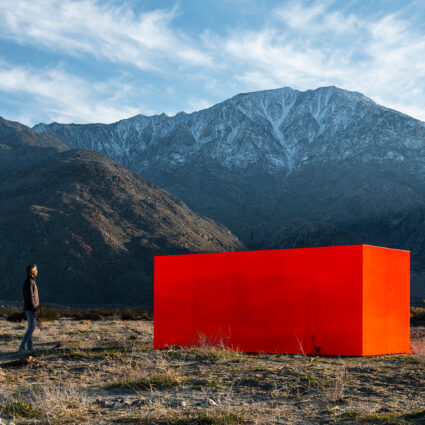
If you’re celebrating landscape as a pure aesthetic category, Subhankar Banerjee explains from his office in the Art & Ecology Department on the University of New Mexico’s campus, “it is a crime.” Instead, in his photography, essays, and teaching, Banerjee works in the realm of critical documentary, a genre that doesn’t depoliticize place but instead applies a critical lens to it by acknowledging the complexities of culture, ecology, imperialism, and history.
Banerjee’s photography largely records animals, migration, and Indigenous life in two places that have become touchstones of ecological crisis: the Arctic and the desert. As a medium that carries the connotation of presenting the truth, photography bears certain ethical responsibilities with which purely conceptual work is, perhaps, unencumbered. Banerjee’s art is bound to the complexities of life and place—complexity being as close as we can get to truth when examining all that becomes embedded in a given environment. His body of work is an object of investigation, containing the complicated politics of the ways we regard nature and the many implications of that gaze. The end result is art that is both poetic and political, eyeing not just what we have lost—or are in danger of losing—but guessing at all that we will never know that we have lost.
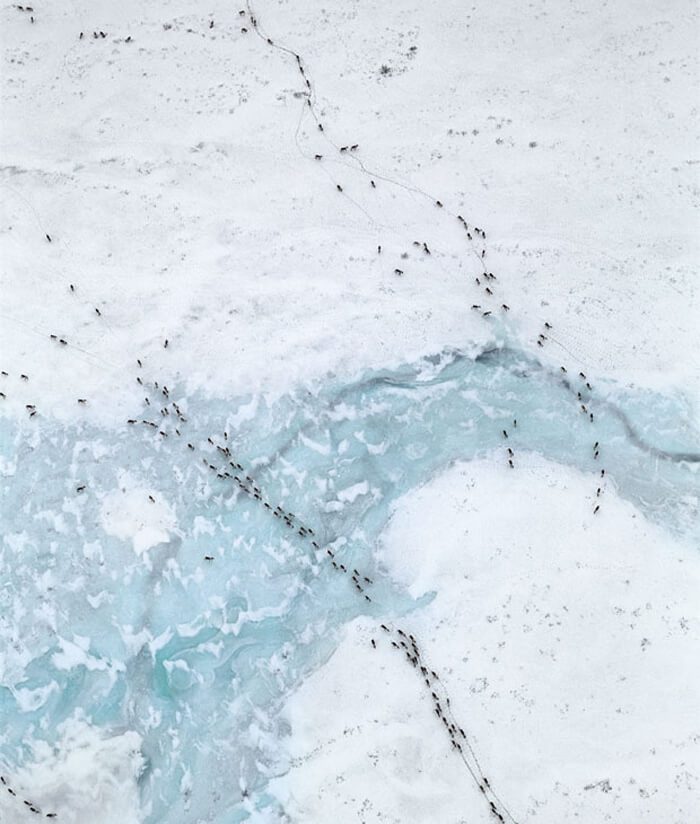
“The word ‘landscape,’” he explains, “I don’t use that term much anymore. That genre—going back to painting, too, not just photography—is about the fetishization of land.” The idealization of landscapes involves removing what’s human from the scene in favor of creating a false narrative—that these lands are somewhere distant and imaginary: “untouched” and “pristine.” Historically, that has meant expunging the people who have lived for thousands of years in these places from the composition. “Within the U.S. context, it has contributed greatly to erasing Indigenous habitation and criminalizing traditional practice,” Banerjee explains. “It is a very problematic word.” See, for example, the establishment of Yellowstone National Park. The landscape genre did a great deal of legwork to evoke public sentiment that this land was, indeed, worth saving. Yet, “that place was created explicitly through a criminal act by conservationists. They promoted the idea that Yellowstone Plateau has never been trodden by human footsteps. Yet five tribes actively lived, hunted, and subsisted there.” In the otherwhere they created through their art, landscape painters and photographers had erased the people who are native to those lands. “Their subsistence hunting was called ‘poaching’; they were called ‘squatters.’ Landscape photography and painting made that endeavor possible in favor of the settler—white society,” Banerjee explains.
The idealization of landscapes involves removing what’s human from the scene in favor of creating a false narrative—that these lands are somewhere distant and imaginary: “untouched” and “pristine.”
The depiction of a landscape as pure, empty, and untouched can be a violent narrative to publicize, particularly given the connotation of photography as “true.” There is no pure aesthetic category of landscape, and that genre too often betrays the nature of “place,” the word Banerjee prefers. Place can evidence something richer—a “real place where people are living, where animals are giving birth. It isn’t bound to this moralistic feeling of appreciating something ‘out there’; it’s a more complex idea of ecology.”
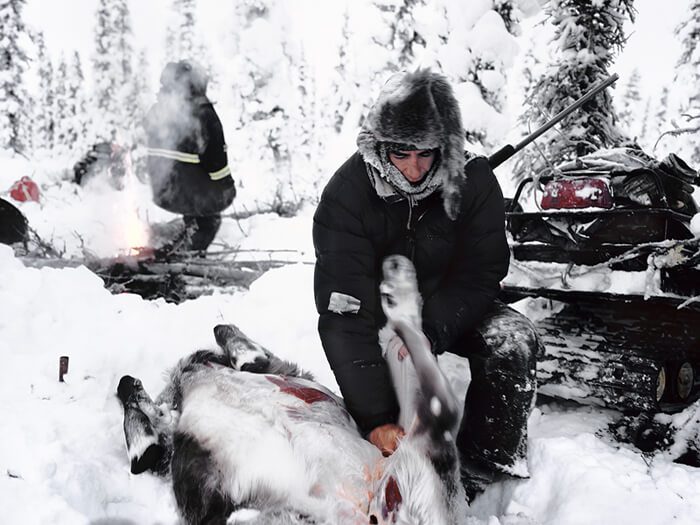
In an exhibition of Banerjee’s work last year, Long Environmentalism in the Near North at the UNM Museum of Art, he sidestepped what he often sees produced by landscape photography, that is “a comfortable emotional feeling, leading to romanticization.” Instead, by pairing a massive landscape of caribou migrating across stretches of tundra with smaller photographs of Gwich’in people preparing the meat of animals from that same herd, viewers are led to investigate assumptions about the Arctic and acknowledge the intricacies of place, tradition, subsistence, and the genre of landscape itself. “That juxtaposition is where art comes in,” Banerjee explains. That the viewers have to step away from the comfortable portrait of migration but step closer to see the photographs of butchering creates the opportunity for interrogation. The romance of the first image is intentionally undercut. “It’s not a pristine place untouched by man. People have lived there for ten thousand plus years and continue to live there and have a complex relationship with these animals that the viewer may or may not romanticize. Here is where art comes in with its slow, complex reading.”
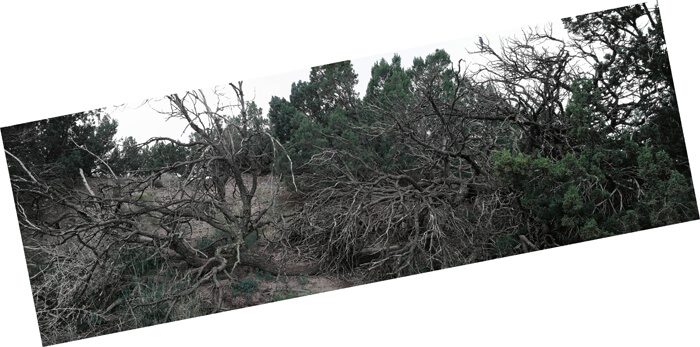
As nuanced and forward-looking as his own artistic work is, Banerjee finds his energies increasingly directed toward teaching, fostering critical dialogues, writing (both for scholars and for wider audiences), and working on expansive collaborations addressing what he has dubbed “biological annihilation”—the massive die-off of species worldwide. “I’m not interested in my career as an artist anymore,” he reiterated. “It isn’t about my work anymore. I’m more interested in the intergenerational component now. What will my students do?” Such intergenerational, interdisciplinary projects that aim for social transformation are all in the name of one of Banerjee’s core values: engagement.
“The moment you say ‘solution,’ then you sit back and relax. I have no interest in solution. It is only about engagement. The crisis is unfolding at such an enormous scale, so to say that I have a solution is disingenuous.”
Engagement is the objective of his varied work, more so than arriving at the endpoint of a solution. In fact, he finds that notion—solution—disempowering. “The moment you say ‘solution,’ then you sit back and relax. I have no interest in solution. It is only about engagement. The crisis is unfolding at such an enormous scale, so to say that I have a solution is disingenuous.” When I ask him how we can maintain a sense of hope in the face of such catastrophe, he points out that even “to despair” is an active verb. To find hope is “a slow process; it’s not a spectacular process,” he says, “It’s a community-building process.” This process underlines much of his work going forward, which includes an upcoming group show, Species in Peril along the Rio Grande, which he co-curated at 516 Arts in Albuquerque, and international initiatives on the crisis of biological annihilation that will launch in the fall.
For now, “the only thing I can say,” Banerjee affirms after he describes the birds that are outside building nests in the cholla and before we hang up the phone, “is to engage. Engage in an expansive way. Engage in a broad way.” An idea that can, perhaps, lead us to hope and, if not solutions, at least put us somewhere on the path toward reconciliation.
